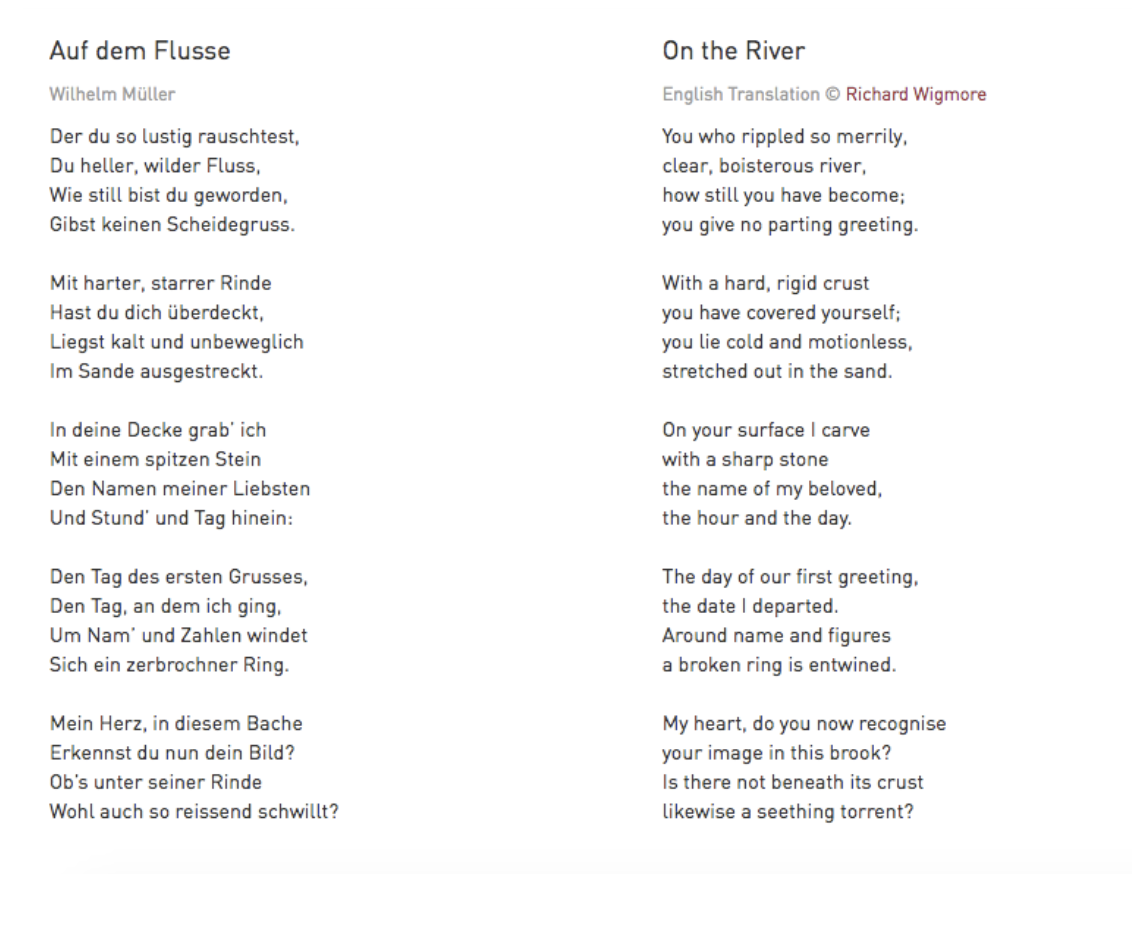Dear Students,
As well as being a solo instrument, the piano can also be an accompanying instrument. There is a lot of music written for solo instruments (such as flute, violin, cello etc.) and solo voice with piano accompaniment.
Piano accompaniment is very different from solo playing, requiring a lot of skills.
In order to be an effective accompanist we must be able to:
- Listen well and follow the soloist.
- Understand it’s not our solo performance.
- Balance sound levels effectively.
- Make no mistakes – there’s no room for error when we accompany someone!
Today I’m going to share a song, from a collection composed by Franz Schubert. The song comes from the song cycle Winterreise.
Winterreise is a set of 24 poems written by Wilhelm Muller. Schubert set each poem to music for male voice and piano. Winterreise translates as “Winter Journey”, and the poems speak of lost or unrequited love. Schubert matched the emotional intensity of the poems in his music, resulting in a hauntingly beautiful collection of songs (or song cycle).
Auf Dem Flusse from Winterreise
This piece, and the whole Winterreise song cycle, falls under the Lieder genre. A Lied is German song written for solo voice and piano accompaniment. They were a popular art form in the 19th century (the Romantic era). The theme of lieder is often about love.
One of the most important aspects when setting text to music is that the music reflects the song’s lyrics. This helps to heighten our emotions when we listen to it. Scroll down for the original German text and translation.
The song is sung by Thomas Quasthoff and accompanied by Daniel Barenboim.
What to listen for:
- The piece opens with simple, staccato accompaniment in the right hand of the piano, whilst the left hand plays a stepwise melody – first descending then ascending.
- It is written in a minor key (E minor) – we know this because it sounds sad.
- The voice enters at 0:19 following the same linear pattern of the piano melody.
- Notice how the musical expression matches the words at 0:31, where the dynamics suddenly drop on the words “how silent”. This is known as word painting.
- The second stanza (or verse) begins at 0:42 and repeats the melody of the first verse.
- At 1:15 the piano pushes us into the parallel major key (E major) for verse 3 – it sounds bright and happy. This is a very definite modulation (change of key), but it’s quickly undermined by the addition of other black notes at 1:19, creating what we call tonal ambiguity – are we in the major key or the minor key?! It’s a little unsettling.
- Why does this happen? Well let’s look at the lyrics for a clue. In this verse, the singer is remembering his first meeting and eventual parting with his love – it’s nostalgic and bittersweet. The major key reflects the happiness of the memory, and the interfering minor harmonies are the sad twinges that are felt by recalling this.
- Throughout the third stanza the piano accompaniment is a little different rhythmically (instead of a steady “coffee-coffee” rhythm accompaniment we hear “coffee-cocacola”, and then later a triplet rhythm “saturday-saturday” – can you hear this change?). This gives the effect of speeding up and slowing down – perhaps a nod to the imagery of the stream from the opening verse. It could also be a preparation for the explosion of emotions we will hear a little later in the piece.
- Between 2:00-2:05 the piano takes us back into the minor key – did you hear the modulation? We are ready for verse five at 2:09.
- There is a dramatic surge at 2:30, reflecting the violent imagery in the text (the “raging torrent” of the stream). The words of this stanza are repeated until the end of the piece.
- The piece draws to a close from 3:39, mirroring the staccato chords from the opening, and ending with a spread chord.
- The final note in the right hand of the piano (a B) gives the feeling of something not quite finished. Since we are ending in the key or E minor, we expect to hear an E, which would give us a satisfying ending, sounding finished. But just like the protagonist’s doubts and emotions – the piece is left somewhat unresolved.
Who was Franz Schubert?
Schubert (1797-1828) was an Austrian composer. He was a gifted musician as a child, and played piano, violin and organ, and also had a beautiful voice. In spite of his short life, he left a vast array of wonderful works, composed in the late-Classical and Romantic styles. He wrote over 1,500 works, 630 of which were compositions for solo voice and piano.
Who is Thomas Quasthoff?
Thomas Quasthoff was born in Germany in 1959 and is a bass-baritone singer. He was born with severe birth defects caused by thalidomide. Luckily, this did not impede an enormous musical talent. Quasthoff retired from public performance in 2012, but continues to teach.
Who is Daniel Barenboim?
We heard Barenboim a few weeks ago, playing Beethoven’s Sonata No. 8. He was born in Argentina and is a famous pianist and conductor.
What is a song cycle?
A song cycle is a group of songs designed to be performed in sequence in their entirety.
What is word painting?
Also known as text painting or tone painting, word painting is a musical technique in which music is composed to reflect the words.

Today Imogen is sharing her ABRSM Grade 2 piece Dusty Blue. Imogen was due to take her Grade 2 exam this summer and has worked really hard at her pieces and scales. Well done Immy, I’m really proud!
I’d love all of you to share your playing, so do please have a think of something that you’d like to perform.

